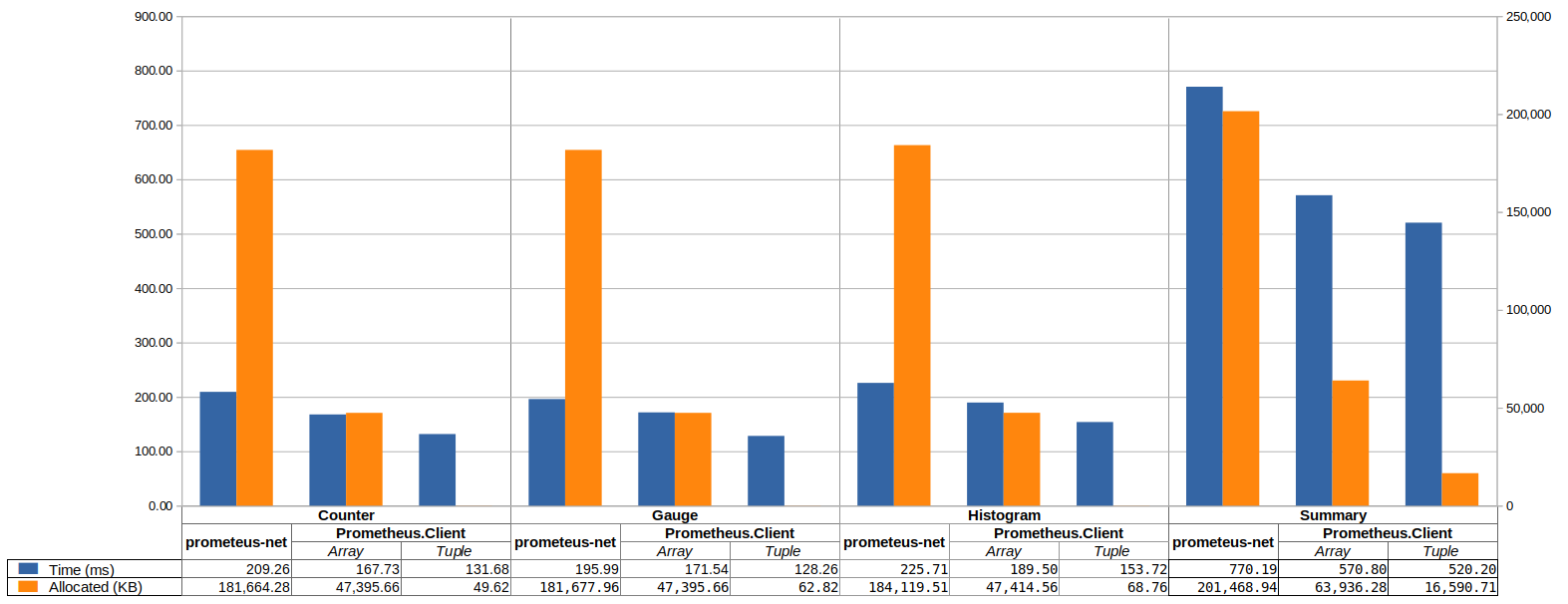.NET Client library for prometheus.io
It was started as a fork of prometheus-net, but over time the library was evolved into a different product. Our main goals:
- Keep possibility of rapid development.
- Extensibility is one of the core values, together with performance and minimal allocation.
- We are open for suggestions and new ideas, contribution is always welcomed.
 Find more details on benchmarks description
Find more details on benchmarks description
dotnet add package Prometheus.Client| Name | Description |
|---|---|
| Prometheus.Client.AspNetCore | ASP.NET Core middleware |
| Prometheus.Client.DependencyInjection | DependencyInjection support |
| Prometheus.Client.HttpRequestDurations | Metrics logging of request durations |
| Prometheus.Client.MetricPusher | Push metrics to a PushGateway |
| Prometheus.Client.MetricPusher.HostedService | MetricPusher as HostedService |
| Prometheus.Client.HealthChecks | HealthChecks Publisher |
| Prometheus.Client.MetricServer | Standalone Kestrel server |
| Prometheus.Client.Owin | Owin middleware |
- Add
IMetricFactoryandICollectorRegistryinto DI container with extension libraryPrometheus.Client.DependencyInjection
public void ConfigureServices(IServiceCollection services)
{
services.AddMetricFactory();
}- Add metrics endpoint
With Prometheus.Client.AspNetCore:
public void Configure(IApplicationBuilder app, IHostingEnvironment env, ILoggerFactory loggerFactory, IApplicationLifetime appLifetime)
{
app.UsePrometheusServer();
}Or without extension:
[Route("[controller]")]
public class MetricsController : Controller
{
private readonly ICollectorRegistry _registry;
public MetricsController(ICollectorRegistry registry)
{
_registry = registry;
}
[HttpGet]
public async Task Get()
{
Response.StatusCode = 200;
await using var outputStream = Response.Body;
await ScrapeHandler.ProcessAsync(_registry, outputStream);
}
}For collect http requests, use Prometheus.Client.HttpRequestDurations.
It does not depend of Prometheus.Client.AspNetCore, however together it's very convenient to use:
public void Configure(IApplicationBuilder app, IHostingEnvironment env, ILoggerFactory loggerFactory, IApplicationLifetime appLifetime)
{
app.UsePrometheusServer();
app.UsePrometheusRequestDurations();
}Four types of metric are offered: Counter, Gauge, Summary and Histogram.
See the documentation on metric types
and instrumentation best practices
on how to use them.
Counters go up, and reset when the process restarts.
var counter = metricFactory.CreateCounter("myCounter", "some help about this");
counter.Inc(5.5);Gauges can go up and down.
var gauge = metricFactory.CreateGauge("gauge", "help text");
gauge.Inc(3.4);
gauge.Dec(2.1);
gauge.Set(5.3);Summaries track the size and number of events.
var summary = metricFactory.CreateSummary("mySummary", "help text");
summary.Observe(5.3);Histograms track the size and number of events in buckets. This allows for aggregate calculation of quantiles.
var hist = metricFactory.CreateHistogram("my_histogram", "help text", buckets: new[] { 0, 0.2, 0.4, 0.6, 0.8, 0.9 });
hist.Observe(0.4);The default buckets are intended to cover a typical web/rpc request from milliseconds to seconds.
They can be overridden passing in the buckets argument.
All metrics can have labels, allowing grouping of related time series.
See the best practices on naming and labels.
Taking a counter as an example:
var counter = metricFactory.CreateCounter("myCounter", "help text", labelNames: new []{ "method", "endpoint"});
counter.WithLabels("GET", "/").Inc();
counter.WithLabels("POST", "/cancel").Inc();Since v4 there is alternative new way to provide a labels via ValueTuple that allow to reduce memory allocation:
var counter = metricFactory.CreateCounter("myCounter", "help text", labelNames: ("method", "endpoint"));
counter.WithLabels(("GET", "/")).Inc();
counter.WithLabels(("POST", "/cancel")).Inc();Contributions to the package are always welcome!
- Report any bugs or issues you find on the issue tracker.
- You can grab the source code at the package's git repository.
We much appreciate free licenses provided by JetBrains to support our library.
All contents of this package are licensed under the MIT license.





